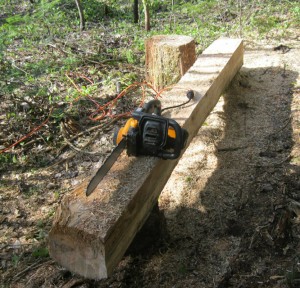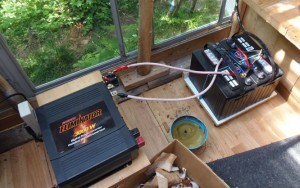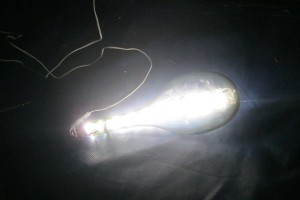My solar electricity system began with design parameters and a problem. The problem was the lack of other forms of viable power. I am too far from the grid if even I were interested in connecting, and too far from running water of any amount for hydroelectric power. As well, the cabin is too sheltered for a windmill, even though I could build a tower and put a windmill on top of that. Such a construction would create new problems. The mast would be visible and the spinning blades might attract people who otherwise would not know I was here. A human construction in the woods is like honey to bees.
windmill, even though I could build a tower and put a windmill on top of that. Such a construction would create new problems. The mast would be visible and the spinning blades might attract people who otherwise would not know I was here. A human construction in the woods is like honey to bees.
I was left with solar power and batteries.
I tinkered with the idea of compressed air or a water tower for storage, but they both demand greater outlay and dubious utility by comparison to batteries.
Once the decision was made to focus on solar, I needed to know how large a system I wanted. Theoretically, I could build as large as my roof, or platforms, would allow. I thought through what I wanted to run and realized that the highest wattage machine would be my electric chainsaw. I found the one I wanted: a Worx Model # WG303.1 16 inch bar chainsaw. It runs on 14.5 amps, or 2500 watts at 120 volts not counting start-up surge. To run it, I would need some decent battery capacity and enough panels to keep the batteries topped up.
machine would be my electric chainsaw. I found the one I wanted: a Worx Model # WG303.1 16 inch bar chainsaw. It runs on 14.5 amps, or 2500 watts at 120 volts not counting start-up surge. To run it, I would need some decent battery capacity and enough panels to keep the batteries topped up.
When debating the batteries versus panels, I was confronted by another design decision. If I ran my chainsaw at peak solar producing hours, I could get by with less storage, and since batteries are not only expensive but limited to ten years or so of life, I decided to buy more solar wattage and less batteries. The solar panels are guaranteed for ten years at 90% of listed capacity and twenty-five years of 80% output. Given the difference in price and ability to produce, the decision was obvious.
I had bought a 100 watt solar panel from Windy Nation, and it had performed excellently. I was less impressed with the inexpensive Pulse Width Modulated charge controller from them as well, but it was just under thirty dollars. The panel was one hundred and fifty dollars, or 1.5 dollars a watt, but such was its performance that I bought five more.  Now I had six hundred watts of power. Next I needed to decide on what type of charge controller to use. The PWM, cheap as it was, does not allow as much power through to the batteries as a MPPT one so I went with two 25A 300W MPPT solar charge controllers (regulator 12V LCD) which I hooked to two banks of three hundred watts each, or three solar panels wired in parallel.
Now I had six hundred watts of power. Next I needed to decide on what type of charge controller to use. The PWM, cheap as it was, does not allow as much power through to the batteries as a MPPT one so I went with two 25A 300W MPPT solar charge controllers (regulator 12V LCD) which I hooked to two banks of three hundred watts each, or three solar panels wired in parallel.
The wiring from the controllers grows a bit more complex. The main wire to the batteries, which are two RV batteries with 200 amp hour life (and only two or three hundred life cycles) wired in parallel, goes through the sixty amp fuse of my 92 Civic fuse box. An offshoot of that power goes into the house system through both a twenty amp and a ten amp auto fuse and a ten amp ammeter wired into the household circuit. This feed also goes to the workshop on the twelve volt line.
The batteries are wired to the charge controller with 0 gauge wire clamped to connectors made from copper plumbing pipe. On the positive line to the inverter I have placed a two hundred and fifty amp breaker, which trips all the time when I am using the chainsaw.
On the positive line to the inverter I have placed a two hundred and fifty amp breaker, which trips all the time when I am using the chainsaw.
The inverter is a Motomaster, Canadian Tire 3000 watt inverter, although I think it is lucky to output that even for the few seconds of surge when my chainsaw starts. It works well enough, however, and I have wired two receptacles in the cabin and one power bar in the workshop to its output.
I have only once driven the batteries below twelve volts and had the inverter cut off power. That was before I installed the circuit breaker inline with the inverter. Now, it trips and the battery charge—even on a cloudy day with no direct sun—doesn’t fall below thirteen volts. I run the chainsaw in short bursts of no more than five to seven seconds and that keeps the breaker from tripping. It also allows time for the batteries to recharge. Other equipment, or course, I can run for longer.
For cabin power I mostly use twelve volts wired through Edison style receptacles and making use of modern plugs  which have polarity. Any modifying of the twelve volts is done at the device, and I use small 7808-style linear voltage regulators to do that. The only exception to that is the usb charging station, which has been cannibalized from an old battery storage unit commonly sold at hardware stores. I also run an adaptor made for laptop charging in a car which gives a cleaner and more consistent voltage than my household power. That is better for 12 volt electronics, which in my case is 20 volt output for my old laptop.
which have polarity. Any modifying of the twelve volts is done at the device, and I use small 7808-style linear voltage regulators to do that. The only exception to that is the usb charging station, which has been cannibalized from an old battery storage unit commonly sold at hardware stores. I also run an adaptor made for laptop charging in a car which gives a cleaner and more consistent voltage than my household power. That is better for 12 volt electronics, which in my case is 20 volt output for my old laptop.
For AC tools, I run a band saw, electric hand planer, skill saw, whippersnapper, jig saw, as well as the chainsaw. On the DC side, I have a weak DC rotary saw, cordless drills I have converted to corded twelve volts using long polarized cords from vacuum cleaners, and three radios, two of which can run my MP3 player. I also use my laptop, as well as inside LED lighting,  although my reading light runs on a separate system with a solar panel I made for the purpose.
although my reading light runs on a separate system with a solar panel I made for the purpose.
In short, I have power to burn. Eventually, I suppose, I could learn to waste it as willnilly as people do in houses, but for now I am more than satisfied to string electric cords together until I am hundreds of feet from the cabin and sawing huge planks out of a fallen pine tree while the sun pours energy into my solar panels on the roof.
